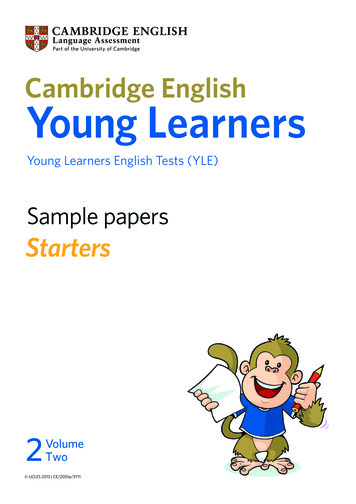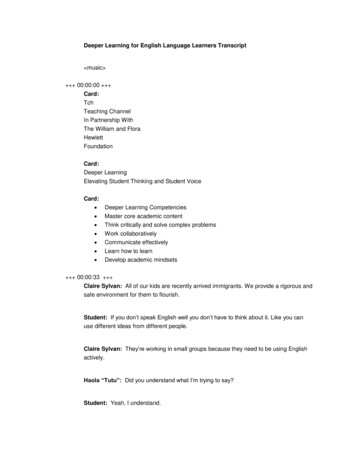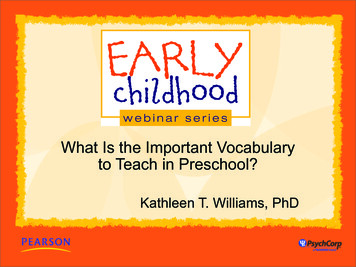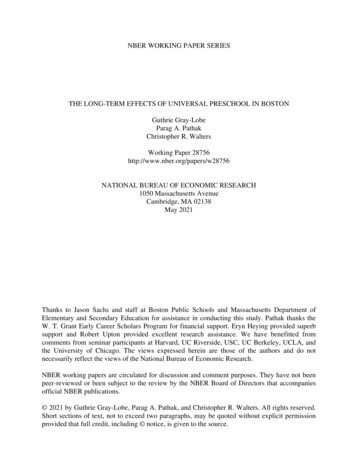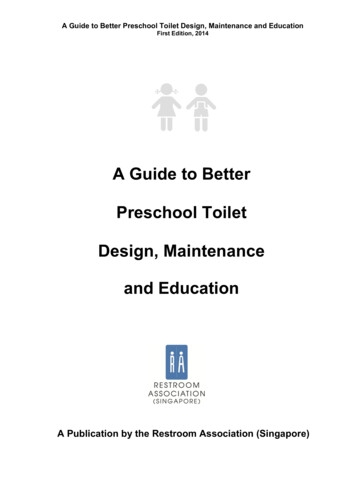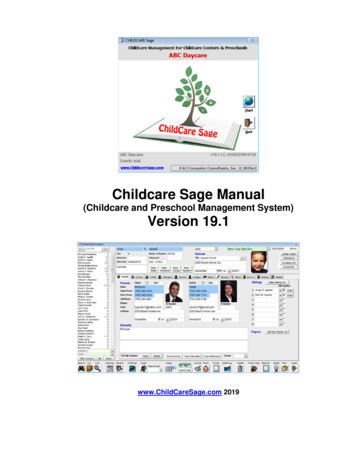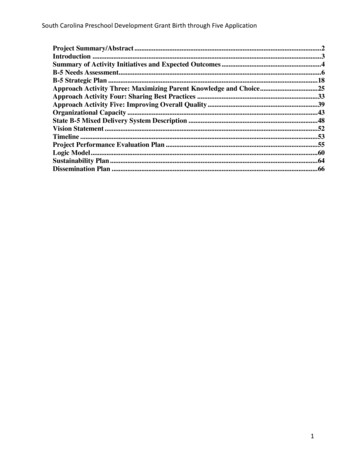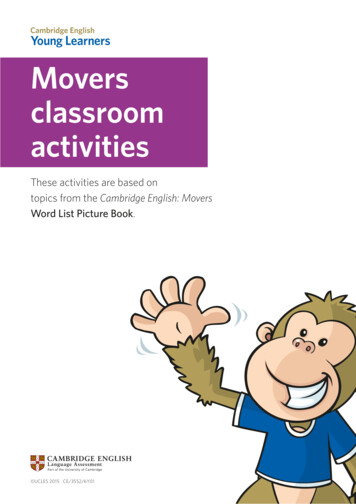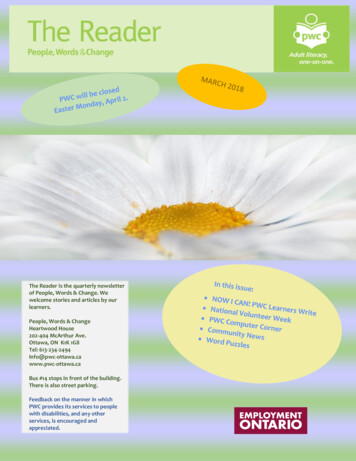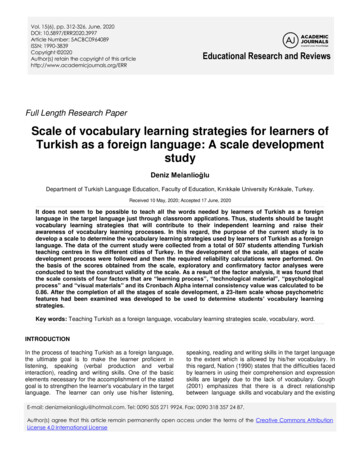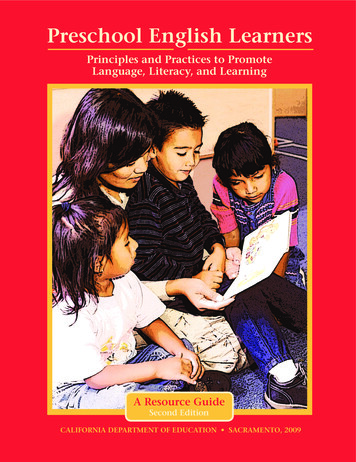
Transcription
Preschool English LearnersPrinciples and Practices to PromoteLanguage, Literacy, and LearningA Resource GuideSecond EditionCalifornia Department of Education Sacramento, 2009
Preschool English LearnersPrinciples and Practices to PromoteLanguage, Literacy, and LearningA Resource GuideSecond Edition
Publishing InformationPreschool English Learners: Principles and Practices to PromoteLanguage, Literacy, and Learning—A Resource Guide (Second Edition)was developed by WestEd’s Center for Child and Family Studiesfor the Child Development Division, California Department ofEducation. It was prepared for printing by the staff of CDE Pressunder the direction of Tom Mays. It was edited by Faye Ong,working in cooperation with Sy Dang Nguyen, Consultant, ChildDevelopment Division. The cover and interior were designed byCheryl McDonald; typesetting was done by Jeannette Reyes. Itwas published by the Department, 1430 N Street, Sacramento, CA95814-5901. It was distributed under the provisions of the LibraryDistribution Act and Government Code Section 11096. 2009 by the California Department of EducationAll rights reservedISBN 978-0-8011-1703-9Ordering InformationCopies of this publication are available for sale from theCalifornia Department of Education. For prices and orderinginformation, please visit the Department Web site at https://www.cde.ca.gov/re/pn/ or call the CDE Press Sales Office at (800) 995 4099. An illustrated Educational Resources Catalog describingpublications, videos, and other instructional media available fromthe Department can be obtained without charge by writing to theCDE Press Sales Office, California Department of Education, 1430N Street, Suite 3207, Sacramento, CA 95814-5901; FAX (916)323-0823 or by calling the CDE Press Sales Office at the telephonenumber shown above.NoticeThe guidance in Preschool English Learners: Principles and Practices toPromote Language, Literacy, and Learning—A Resource Guide (SecondEdition) is not binding on local educational agencies or other enti ties. Except for the statutes, regulations, and court decisions thatare referenced herein, the document is exemplary, and compliancewith it is not mandatory. (See Education Code Section 33308.5.)ii
ContentsA Message from the State Superintendent of Public Instruction . vAcknowledgments . viChapter One: Introduction to the Resource Guide . 1What You Will Find in This Guide . 2Core Beliefs . 3Principles and Practices: Children as Active Learners . 4Summary of the Guide by Chapter . 5Continued Professional Development. 6Chapter Two: Preschool English Learners,Their Families, and Their Communities . 9The Children . 10The Role of Families in Language and LiteracyDevelopment. 13The Diversity of the Immigration Experience . 14Connecting School and the Home Language . 14Varieties of Language . 17Chapter Three: Connecting Firstand Second Languages . 19Children and Their Language Development . 20The Components of Language. 22A Wide Range of Language Practices . 25Awareness of How Language Works . 29The Influence of Peers on Language Development . 30Chapter Four: Paths to Bilingualism . 33Theoretical Basis for Supporting Bilingualism. 34Simultaneous Bilingualism . 36Early Phase (Birth to Three Years) . 37Middle Phase (Three to Four Years) . 38Later Phase (Five to Six Years) . 39Successive Bilingualism . 41Receptive Bilingualism . 42iii
Chapter Five: Stages and Strategiesin Second-Language Acquisition . 45Stages of Learning a Second Language . 46The Use of the Home Language to Communicate . 47The Observational and Listening Period . 47Telegraphic and Formulaic Speech . 48Fluid Language Use . 50Strategies in Second-Language Acquisition . 52Chapter Six: Code Switchingand Language Loss . 57Code Switching . 58Language Loss . 60Chapter Seven: English Learners with Disabilitiesor Other Special Needs . 63A Language Disorder Versus a Language Difference. 64Special Education Programs and English Learners . 65Coordinating Language and Communication Goals . 68Chapter Eight: Recommended Early LiteracyPractices . 71Defining Early Literacy . 72Connecting Home and School Literacy Practices. 73Teaching Through Language . 76Reading Books Aloud to English Learners . 77Writing as a Part of Early Literacy. 80Making Stories Come Alive . 81Literacy Strategies for English Learnerswith Special Needs . 83AppendixesA. Principles for Promoting Language, Literacy,and Learning for Preschool English Learners . 93B. Prekindergarten Learning and DevelopmentGuidelines . 94C. Desired Results for Children and Families. 99D. California Preschool Learning Foundations . 102E. Transition to Kindergarten or Elementary School . 114Glossary . 124Works Cited . 129iv
A Message from the State Superintendentof Public InstructionFamilies, teachers, and policymakers have become increasingly aware ofthe need to address the linguistic diversity of California’s preschool stu dents, many of whom are experiencing formal schooling for the first time.The teachers of preschool children have long been sensitive to the culturalbackgrounds of the students and their families. Now they seek guidance asto how best to educate children from homes in which a language other thanEnglish is spoken and to prepare these English learners for their transitioninto kindergarten or elementary school.This resource guide, Preschool English Learners: Principles and Practices toPromote Language, Literacy, and Learning (Second Edition), provides teacherswith the knowledge and tools they seek to educate preschool English learnersmost effectively. It was developed by a group of experts who collectivelybrought strong practical, academic, and research backgrounds to the topicof educating young English learners. In their work the group demonstratedits steadfast commitment to assisting such children enrolled in California’sschools and their families.This document builds on the foundation laid by an earlier version titledFostering the Development of a First and a Second Language in Early Childhood,published in 1998. In addition, companion materials, including a video, aWeb site, and materials for statewide training, will be developed to supple ment the information contained in the guide. This guide is meant to be usedin conjunction with Appendix B, “Prekindergarten Learning and Develop ment Guidelines”; Appendix C, “Desired Results for Children and Families”;Appendix D, “California Preschool Learning Foundations”; and Appendix E,“Transition to Kindergarten or Elementary School”; which can be found atthe back of this publication.I hope that teachers will find this resource guide useful as they work toprovide high-quality preschool programs for all children. Thank you for yourefforts on behalf of our children.Jack O’ConnellState Superintendent of Public Instructionv
AcknowledgmentsThis publication was developed for the California Department ofEducation, Child Development Division, under the direction ofRebeca Valdivia, Director of the English Language Learning forPreschoolers Project, WestEd’s Center for Child and Family Studies. Sadly,Rebeca, the lead writer of this document, lost a courageous battle withcancer on October 21, 2008. The CDE dedicates this publication to Rebecafor her countless contributions to the lives of young children, especiallyyoung English learners and children with special needs. This undertakingwould not have been possible without the expertise and contributions ofthe many talented people who deserve our sincerest gratitude for their time,energy, and dedication. They include a panel of experts, staff from theCalifornia Department of Education’s Child Development Division, stafffrom WestEd’s Center for Child and Family Studies, and 50 focus-groupparticipants from around the state representing the various audiences thatthe guide is designed to reach.Panel of ExpertsThe panel of experts provided academic and practical perspectives affectingall aspects of the guide. Contributions to the contents, principles and prac tices, and updated research were generated by the panel during the 2003-04contract year. Panel members and their job titles and locations are listed asfollows:Patricia Baquedano-Lopez, Associate Professor, Graduate School ofEducation, Language and Literacy, Society and Culture, University ofCalifornia, BerkeleyMaria Fátima Castro, Coordinator, Central California Migrant Head Start,Santa Cruz County Office of Education, CapitolaRuth Chao, Associate Professor, Department of Psychology, Universityof California, RiversideAnna Eunhee Chee, Associate Professor, Charter College of Education,California State University, Los AngelesKris Gutierrez, Professor, Graduate School of Education, Universityof California, Los AngelesJ. Ronald Lally, Co-Director, Center for Child and Family Studies, WestEd,SausalitoPeter Mangione, Co-Director, Center for Child and Family Studies,WestEd, SausalitoSy Dang Nguyen, Consultant, Child Development Division, CaliforniaDepartment of Education, Sacramentovi
Joyce Palacio, Principal, El Sereno Early Education Center, Los AngelesUnified School DistrictJames L. Rodriguez, Associate Professor, College of Education, San DiegoState UniversityCalifornia Department of EducationThanks are also extended to the following members of the Department’sChild Development Division: Michael Jett, Director, whose vision andleadership inspired the development of the project; Gwen Stephens,Assistant Director, Quality Improvement and Capacity Building; andSy Dang Nguyen, Consultant, for ongoing revisions and recommendations.Project StaffThe writing, editing, and reviewing involved in any project cannot becompleted without the tireless work of dedicated staff. The contributionsof the following staff members from WestEd’s Center for Child and FamilyStudies are gratefully acknowledged: Peter Mangione, for writing aconsiderable amount of the contents throughout the guide, editing multipledrafts, and providing administrative support, guidance, and oversight;Carrie Parente, for design, editorial, formatting, and administrativeassistance; Sara Webb, for helping with the design and layout; andJ. Ronald Lally and Catherine Tsao, Director, National and InternationalTraining, for proofreading.Special ContributionsSpecial thanks go to Marilyn Astore, member of the Executive Committee,California Preschool Instructional Network. She reviewed several drafts of theguide, provided important recommendations concerning the presentation ofcontent, especially in the chapter on early literacy, and contributed sugges tions for resources and references.Special thanks also go to Joyce Palacio, a member of the panel of experts,and Norma Quan Ong, an independent early childhood consultant in SanFrancisco. They contributed vignettes taken directly from children, families,and staff in early childhood settings.Focus GroupsFour focus groups were assembled by WestEd in San Diego, San Francisco,El Centro, and Los Angeles. The 50 participants were preschool teachers,program directors from early childhood education programs, trainers, consul tants, and parents. They examined an earlier draft of the guide and providedcrucial feedback for improving its readability and accessibility for the targetaudience.vii
EditorsRosario Diaz Greenberg, Associate Professor, California State University,San Marcos, and James Rodriguez, a member of the panel of experts, provid ed invaluable expertise during the extensive revision and editing process.PhotographsThe photographs in this guide came from two sources. Julie Espinosa andfamilies in Pasadena, California, graciously contributed photographs. Abouthalf of the photographs were taken by Lang and Associates at the EducationalEnrichment Systems, Inc./Linda Vista Child Development Center in SanDiego. Many thanks are extended to Mark Lang, photographer, DirectorJennifer Anthony, and the children, staff, and families at the center.viii
1Introduction to theResource GuideTucked away in one of the many multiculturalcommunities in California is a state-funded childdevelopment program. There are 15 children inthe class from Spanish-speaking, English-speaking,Vietnamese-speaking, Chinese-speaking, Farsi-speaking, andRussian-speaking homes. Many of the children have grownup together in this early care and education setting fromthe time they were infants. The lead teacher is bilingualin English and Farsi. Two assistants are bilingual in Englishand Spanish. There are also some roving staff members whoare bilingual in Vietnamese and English and some who arebilingual in Chinese and English.1
Chapter 1Introductionto the ResourceGuideEngaged in a variety of activities, the children participatein small-group and whole-class instruction, individualprojects, and adult-child interactions. Student needs,learning goals, and forms of assistance for each child aresome of the factors the teacher has considered in plan ning the day’s activities. The children use their homelanguage and English to learn and to communicate insocial interactions. The director and teacher explainthat program planning has not been easy but that theongoing attention to the children’s language and literacydevelopment in both their home language and Englishhas been a key factor in the children’s progressing in allareas of development as they move on to the class forfour-year-olds in the following year.What You Will Find in This GuideThis guide is designed to help the reader understand the preschoolEnglish learner more fully. Each chapter provides important infor mation about the development, abilities, and everyday experiences ofthe preschool English learner that is based on current and rigorouslyconducted research. The preschool English learner is (1) a child whosefirst language is other than English and as a result is learning English asa second language; or (2) a child who is developing two or more lan guages, one of which may be English. During the preschool years frombirth through five years of age, most children are still acquiring thebasic knowledge of their home language, even when that language isEnglish. The purpose of this guide is to enrich the reader’s understand ing of the language and literacy development of young English learners.The primary audience for this guide is preschool teachers. The termteacher includes preschool classroom teachers, child development centerteachers, and child care providers. Most of the information applies tofamily child care providers working with preschool English learners.This guide should be a starting point for you, the reader, to expand onwhat you already know about preschool children and gain insights intothe unique strengths and needs of preschool English learners.
Core BeliefsThe following list of core beliefs should be considered as informa tion is being presented in this guide. These beliefs stem fromresearch and reflect an understanding of the challenges of educatingpreschool-age children, particularly English learners. Careful consider ation of the beliefs will help preschool teachers focus on each child’sexperiences and circumstances as that child begins the journey towardthe acquisition of academic English. Familiarity with these beliefs willalso help teachers implement the information, principles, and practicespresented in this guide. It is important to recognize that these beliefsare not mutually exclusive and that, in most instances, they overlap.Chapter 1Introductionto the ResourceGuide Understanding the English learner requires gathering as much informationas possible about the child and his or her family and community. Chil dren grow and learn in the contexts of family, school, and commu nity that often influence one another dynamically and interactively.Preschool educators can learn much from their observations ofchildren’s experiences in the multiple contexts of childhood(Bronfenbrenner 1979; Harrison and others 1990). There is an important relationship between language, culture, and learn ing. As children grow older, they become more proficient in the useof language, more culturally knowledgeable, and more competent inlearning. Language allows children to learn more about their family’sculture and the world. At the same time culture provides childrenwith a lens that influences how they experience the world and howthey learn (Gutierrez and Rogoff 2003; Vasquez, Pease-Alvarez, andShannon 1994). Language is a tool for learning. Children’s language is an essential toolenabling them to learn about the world around them. Home lan guage and English are tools children use to learn everything from thecultural practices within the home to the academic content of theclassroom (Gutierrez and Rogoff 2003). There are multiple paths to childhood bilingualism. Just as children’severyday experiences may differ from one another, children mayfollow different paths to developing more than one language. Thereis not a single best path to bilingualism. This diversity in achievingbilingualism reflects overall development whereby children maydevelop specific abilities at different times and at different rates(Hakuta 1986).
Chapter 1Introductionto the ResourceGuide Language development and learning are shaped by children’s experiences.Children acquire skills and strategies and ways of doing things fromthe people around them as the children carry out everyday tasks andactivities. They learn the appropriate use of language and literacy fromexperts (adults and other competent children) in their communities. Second-language acquisition is a complex process. Children take differ ent paths, go through certain stages at different rates, and use variousstrategies in acquiring more than one language. Acquiring oral language fluency in English differs from acquiring academicEnglish, the formal language of the school. Children use English withindifferent contexts for different purposes. As a result children may usedifferent varieties of English in the home, in the classroom, and onthe playground. Academic English used in formal schooling may takelonger to acquire than English used with other children in socialcircumstances, such as on the playground. Being able to communicate in more than one language empowers childrenin a multicultural society. Bilingualism is a valuable skill that allowschildren to use more than one language to experience the world andlearn about it (Valdés 2003).Principles and Practices: Childrenas Active LearnersIn addition to the core beliefs that provide a foundation for this guide,a series of principles and practices is introduced throughout to pro mote language development, literacy, and learning among preschoolEnglish learners, including English learners with disabilities or otherspecial needs. The use of the information, principles, and practicesdescribed will increase opportunities for growth and learning amongEnglish learners. These opportunities are vital to promoting thechildren’s success in school and in life.Throughout the guide the expansion of the English learner’s acquisi tion of learning practices and abilities is emphasized. Achieving academ ic success in school includes developing a knowledge and masteryof formal schooling practices in addition to building on one’s homeor community language practices. All children can have high levels ofachievement if provided with a rich, challenging curriculum andappropriate forms of assistance. When implemented, the informationcontained in this resource guide will help preschool English learnersreach their fullest potential.
The core beliefs introduced earlier in this chapter are extended toprinciples and practices that incorporate the wide range of ways inwhich children can participate in numerous activities in their homes,schools, and communities. As with all other children, the developmentof English learners depends on a number of factors and influencesthat exist within those settings. For English learners in particular, suchfactors and influences would include the status given to their homelanguage, the extent to which their communities and school programsembrace bilingualism, and the supports available to continue develop ing their first language as they develop fluency in English.Children use a wide range of skills, strategies, and behaviors dailyto develop linguistic, academic, and social competencies that facilitatethe children’s emerging ability to participate in the activities of theirfamilies, schools, neighborhoods, and communities. Variation amongthese contexts leads to variation in the language, literacy, and learningtools that children acquire and bring to the preschool context.The more preschool teachers know about how children learn, thebetter prepared the teachers will be to develop rich learning contexts.As preschool educators continue through this guide, they should thinkof children as active learners who draw on their previous knowledgeand experiences to make sense of their world.Chapter 1Introductionto the ResourceGuideSummary of the Guide by ChapterAcentral goal of this resource guide is to emphasize the importanceof understanding the dynamic forces that shape development andlearning among preschool English learners. In this chapter a set of corebeliefs has been presented for consideration in implementing theprinciples and practices introduced throughout the guide. An overalltheme that runs through these core beliefs is that developing a fullerunderstanding of the English learner is an important first step inthinking about and creating effective learning contexts that maximizechildren’s language and literacy learning. A summary of the centralpoints of each of the remaining chapters in the guide is presented asfollows: Chapter Two describes English learners in California and discusses thecrucial role that family members play in the language and literacydevelopment of English learners. The ways in which home, school,and community contexts influence language development andliteracy practices are also explained.
Chapter 1Introductionto the ResourceGuide Chapter Three continues to explore the various factors that oftenaffect language development and literacy among English learners.Among those factors are the literacy skills children bring from theirhome language and the kinds of literacy practices in which theyparticipate. Chapter Four describes the various paths to bilingualism, and ChapterFive provides an overview of how second-language acquisitionoccurs. The role that language plays in the process of learning isemphasized. Children acquire and use language as a tool to partici pate with others in their everyday activities across many contexts. Chapter Six presents the concept of code switching, by which achild can move back and forth between two or more languages. Thechapter once again highlights the finding that children’s languageand literacy development is influenced by factors within the child’sfamily, school, and community. Chapter Seven discusses working with English learners who havedisabilities or other special needs, although most of the strategiessuggested in other chapters can also be effective with this popula tion. The reverse is also true; that is, many of the strategies forchildren with disabilities or other special needs are effective withEnglish learners and preschoolers in general. Chapter Eight presents a set of recommended literacy practices forEnglish learners. Because, like all other children, English learnershave a range of interests and are motivated to participate in manydifferent kinds of learning activities, they should be assigned literacyactivities that allow them to learn about many different topics acrossa number of contexts. Being able to read influences a child’s abilityto write and vice versa, and literacy activities that allow youngchildren to take on roles as both emergent readers and writersincrease literacy development significantly.Continued Professional DevelopmentAlthough this guide provides an up-to-date, comprehensive discus sion of preschool English learners, information on this topic iscontinually expanding and changing. Books have been written on thetopics covered in each of the chapters. The guide provides references,resources, and thought-provoking questions to support continuedprofessional development and a foundation for building on current
Chapter 1Introductionto the ResourceGuideknowledge. To understand and serve the preschool English learnermore fully, teachers should engage in intensive professional develop ment, including coaching and mentoring.Key to the Resource GuideThroughout this guide various categories are used to presentinformation in a different yet accessible manner. Each category hasa different purpose and is represented by the following icons:Research Highlights. Current research related to key topics beingpresented and discussed. One or more references for additionalinformation are provided.Principles and Practices. Instructional strategies teachers canimplement in their classrooms and with families to educatethe preschool English learner more effectively. Each principleprovides the rationale for the practices that follow.Voices from the Preschool Classroom. Voices of teachers, children,and families that exemplify the concept or idea being discussed.Research to Practice. Examples of curriculum and instructionalpractices derived directly from research.
Chapter 1Introductionto the ResourceGuideAsk Yourself1. Do I look at each of my students as an individual who bringscompetencies to the learning situation or as a member ofa group or category, such as English learners?2. Am I familiar with how our program applies provenapproaches on first- and second-language developmentand learning?Additional ReferencesEarly Childhood Head Start Task Force, U.S. Department of Educationand U.S. Department of Health and Human Services. 2002. TeachingOur Youngest: A Guide for Preschool Teachers and Child Care andFamily Providers. https://orders.gpo.gov/EDU/EDUPubs.aspxEastern Stream Center on Resources and Training. 2003. Help! TheyDon’t Speak English Starter Kit: A Resource Guide for Educators ofLimited English Proficient Migrant Students, Grades Pre-K–6.Oneonta, N.Y. Available at 1-800-451-8058.http://www.escort.org/Starting Points for Educators of Culturally and Linguistically DiverseChildren 3 to 8 (video training series). Program 1: “I Don’t KnowWhere to Start” (2002), Program 2: “Getting Your Message Across”(2002), and Program 3: “Bringing Language Alive!” (2003).Beaverton, Ore.: Educational Productions.Note: See pages 129–42 for a list of works cited in this publication.
2Preschool English Learners,Their Families,and Their CommunitiesWhen asked how he successfully communicateswith two- and three-year-old children whohave had limited exposure to English, amonolingual English-speaking teacherreplied: “It’s all about relationships. Children respond to acalm voice and a comforting hug. I’ve learned a few simplephrases in Spanish to reassure children that they are safewhile at our center. I also ask for help from the children whoare learning English. In no time at all, I don’t have to ask,for they automatically translate for the younger children.Translating for the teacher makes them feel special andmakes learning two languages take on greater significance.”9
The ChildrenChapter 2PreschoolEnglish Learners,Their Families,and TheirCommunitiesRecent demographic trends have far-reaching implications forearly childhood educators. By the year 2030 children of EuropeanAmerican families will make up less than 50 percent of the populationunder age five (Shonkoff and Phillips 2000).1 Like many of the otherstates, California is becoming increasingly culturally, ethnically, andlinguistically diverse. Latinos ma
the class from Spanish-speaking, English-speaking, Vietnamese-speaking, Chinese-speaking, Farsi-speaking, and Russian-speaking homes. Many of the children have grown up together in this early care and education setting from the time they were infants. The lead teacher is bilingual in English and Farsi.

